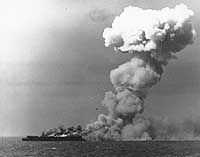
At daybreak on 24 October 1944, as Japanese Navy forces were approaching the Philippines from the north and west, Rear Admiral Frederick C. Sherman's Task Group 38.3 was operating about more than a hundred miles east of central Luzon. With other elements of Admiral William F. Halsey's Third Fleet, TG38.3 had spent the last several days pounding enemy targets ashore in support of the Leyte invasion operation. This morning Sherman's four carriers, Essex, Lexington, Princeton and Langley, had sent off fighters for self-protection and other planes on search missions. Still more aircraft were on deck, ready for attack missions.
Though the Japanese had sent out many aircraft to strike the Third Fleet, most were shot down or driven away. However one "Judy" dive bomber escaped notice and, at 0938, planted a 250 kilogram bomb on Princeton's flight deck, somewhat aft of amidships. It exploded in the crew's galley after passing through the hangar, in which were parked six TBM bombers, each with full gasoline tanks and a torpedo. In its passage, the bomb struck one of these planes, which was almost immediately ablaze. For some reason, the carrier's firefighting sprinklers did not activate and the the entire hangar space was quickly engulfed, while smoke penetrated compartments below. Princeton was still underway, but at 1002 a heavy explosion rocked the after part of the hangar. This blast was followed by three more, which heaved up the flight deck, blew out both aircraft elevators and quickly made much of the ship uninhabitable.
With all but emergency generator power gone, and much of her crew abandoning ship, Princeton now depended on the light cruisers Birmingham and Reno, plus the destroyers Irwin (DD-794) and Morrison (DD-560), to help fight her fires. While alongside, Morrison's superstructure was seriously damage when she became entangled in Princeton's projecting structures. After more than three hours' work, with the remaining fires almost under control, a report of approaching enemy forces forced the other ships to pull away. By the time they returned Princeton was again burning vigorously, heating a bomb storage space near her after hangar. At 1523, as Birmingham came alongside, these bombs detonated violently, blowing off the carrier's stern, showering the cruiser's topsides with fragments, and killing hundreds of men. There was now no hope that Princeton could be saved. Her remaining crewmen were taken off and Irwin attempted to scuttle her with torpedoes and gunfire, but with no success. Finally, Reno was called in to finish the job. One of her torpedoes hit near the burning ship's forward bomb magazine and USS Princeton disappeared in a tremendous explosion.
Princeton was the first U.S. fleet carrier sunk in more than two years, and the last lost during the Pacific War. However, her ordeal by fire would be repeated several times during the six months, as the U.S. Navy closed in on an increasingly desperate Japan.
This page features, and provides links to, all the views we have related to the loss of USS Princeton (CVL-23), during the Battle of Leyte Gulf.
For more images related to Princeton's loss, especially
those involving USS Birmingham, see:
| If you want higher resolution reproductions than the digital images presented here, see: "How to Obtain Photographic Reproductions." |
Click on the small photograph to prompt a larger view of the same image.
|
Photo #: 80-G-287962 Battle of Leyte Gulf, October 1944 USS Princeton (CVL-23) burning, but still underway, about twenty minutes after she was hit by a Japanese air attack, 24 October 1944. Photographed from USS South Dakota (BB-57). Official U.S. Navy Photograph, now in the collections of the National Archives. Online Image: 117KB; 740 x 580 pixels Reproductions of this image may also be available through the National Archives photographic reproduction system. |
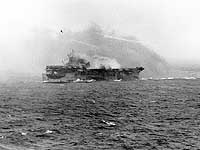 |
|
Photo #: 80-G-270546 Loss of USS Princeton (CVL-23), 24 October 1944 Smoke rises after a massive explosion in Princeton's hangar deck, shortly after she was hit by a Japanese bomb while operating off the Philippines on 24 October 1944. A destroyer is visible at right. Official U.S. Navy Photograph, now in the collections of the National Archives. Online Image: 81KB; 740 x 610 pixels Reproductions of this image may also be available through the National Archives photographic reproduction system. |
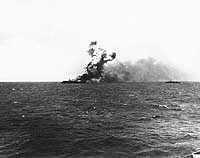 |
|
Photo #: 80-G-287969 Loss of USS Princeton (CVL-23), 24 October 1944 Smoke rises from an explosion in Princeton's hangar deck at 1000.5 hrs. on 24 October 1944, shortly after she was hit by a Japanese bomb while operating off the Philippines. Photographed from USS South Dakota (BB-57). Official U.S. Navy Photograph, now in the collections of the National Archives. Online Image: 79KB; 740 x 610 pixels Reproductions of this image may also be available through the National Archives photographic reproduction system. |
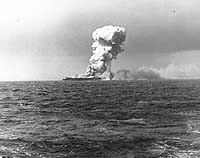 |
|
Photo #: 80-G-287970 Loss of USS Princeton (CVL-23), 24 October 1944 Princeton burning soon after she was hit by a Japanese bomb while operating off the Philippines on 24 October 1944. This view, taken from USS South Dakota (BB-57) at about 1001 hrs., shows the large smoke column passing aft following a heavy explosion in the carrier's hangar deck. Official U.S. Navy Photograph, now in the collections of the National Archives. Online Image: 62KB; 740 x 605 pixels Reproductions of this image may also be available through the National Archives photographic reproduction system. |
 |
|
Photo #: 80-G-287972 Loss of USS Princeton (CVL-23), 24 October 1944 Princeton suffers another tremendous explosion, soon after she was hit by a Japanese bomb while operating off the Philippines on 24 October 1944. Photographed at about 1003 hrs. from USS South Dakota (BB-57), with USS Reno (CL-96) passing by closer to the camera. Official U.S. Navy Photograph, now in the collections of the National Archives. Online Image: 52KB; 740 x 605 pixels Reproductions of this image may also be available through the National Archives photographic reproduction system. |
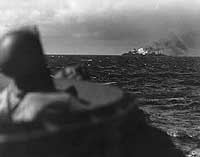 |
|
Photo #: 80-G-287974 Battle of Leyte Gulf, October 1944 USS Princeton (CVL-23) afire at about 1004 hours on 24 October 1944, soon after she was hit by a Japanese bomb during operations off the Philippines. This view shows smoke rising from the ship's second large explosion, as USS Reno (CL-96) steams by in the foreground. Photographed from USS South Dakota (BB-57). Official U.S. Navy Photograph, now in the collections of the National Archives. Online Image: 83KB; 740 x 605 pixels Reproductions of this image may also be available through the National Archives photographic reproduction system. |
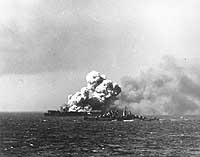 |
|
Photo #: 80-G-270430 Battle of Leyte Gulf, October 1944 USS Reno (CL-96) comes alongside the burning USS Princeton (CVL-23) to assist in fighting fires, 24 October 1944. Princeton had been hit by Japanese air attack earlier in the day. Official U.S. Navy Photograph, now in the collections of the National Archives. Online Image: 71KB; 740 x 595 pixels Reproductions of this image may also be available through the National Archives photographic reproduction system. |
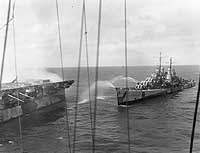 |
|
Photo #: 80-G-270431 Battle of Leyte Gulf, October 1944 USS Reno (CL-96) fighting fires from alongside the port quarter of the burning USS Princeton (CVL-23), 24 October 1944. Princeton had been hit by Japanese air attack earlier in the day. Official U.S. Navy Photograph, now in the collections of the National Archives. Online Image: 72KB; 740 x 575 pixels Reproductions of this image may also be available through the National Archives photographic reproduction system. |
 |
|
Photo #: NH 63439 Battle of Leyte Gulf, October 1944 USS Reno (CL-96) stands off the starboard quarter of USS Princeton (CVL-23), while fighting fires on board the bombed carrier, 24 October 1944. Note Reno's forward 5"/38 twin gun mounts in the foreground, with local fire control sights on top. Official U.S. Navy Photograph, from the collections of the Naval Historical Center. Online Image: 74KB; 740 x 610 pixels |
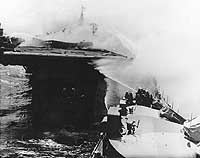 |
|
Photo #: 80-G-281662-6 Loss of USS Princeton (CVL-23), 24 October 1944 Princeton survivors jumping from a motor whaleboat to swim to USS Cassin Young (DD-793), 24 October 1944. Official U.S. Navy Photograph, now in the collections of the National Archives. Online Image: 143KB; 740 x 615 pixels Reproductions of this image may also be available through the National Archives photographic reproduction system. |
 |
|
Photo #: NH 98471-A USS Reno (CL-96) Plaque and letter of appreciation exhibited on board the ship. They were presented by the Commanding Officer of USS Princeton (CVL-23) in recognition of fire fighting assistance and survivor care rendered by Reno on 24 October 1944, when Princeton was fatally damaged by Japanese air attack. See Photo # NH 98471 and Photo # NH 98472 for separate views of these two items. Official U.S. Navy Photograph, from the collections of the Naval Historical Center. Online Image: 74KB; 580 x 765 pixels |
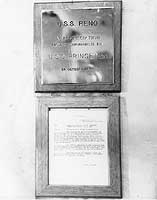 |
For more images related to Princeton's loss, especially
those involving USS Birmingham, see::
| If you want higher resolution reproductions than the digital images presented here, see: "How to Obtain Photographic Reproductions." |
Page made 29 May 2003